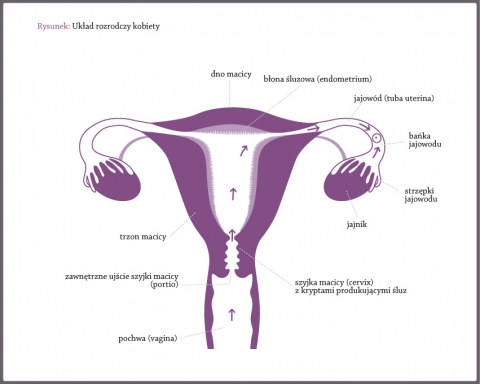The new life starts with the meeting of female and male reproductive cells - the ovum and sperm. Both female and male germ cells must undergo a long process of development in order to achieve a fully mature form.
The sperm formation takes about 70 days. They are produced in the testes that is outside the body because too high temperature adversely affects the process of spermatogenesis. The vas deferens and epididymis store the sperm until ejaculation. Prostate glands and seminal vesicles secrete a special fluid for sperm and this fluid together with the sperm cells is called semen. The discharge of each of these glands provides beneficial alkaline, creating a suitable environment for sperm to survive and be protected against the possibility of damage.
The growth and maturation of the ovarian follicle containing the egg is a cyclical process, repeated in each menstrual cycle. Each female child in fetal life is already equipped with a certain amount of primary follicles deposited in the ovaries (so-called ovarian reserve), but in each cycle only one of them usually reaches the stage of the Graafian follicle.
Ovaries are from 2.5 to 5 cm long and from 1.5 to 3 cm wide. Their function is essential for the human fertility – i.e. the release of mature germ cell. The primary follicles are the nearest to the ovary surface. Then there are growing follicles, more sensitive to follicle stimulating hormone FSH, secreting estradiol and androgens. Among the growing follicles, in the process of natural selection, the one (in exceptional cases more) is chosen, which will mature as a Graafian follicle and will release the egg during an ovulation.
The sperm begins its way to the egg inside the vagina. The vagina is a musculomembranous duct, very extensible and elastic. It is from 6 to 12 cm long with an acidic environment, hostile to sperm. During the fertile period vaginal pH is changed as a result of the secreted alkaline cervical mucus which helps the sperm to survive. After the intercourse the sperm collects in the vaginal vault from where it goes up through the cervix. Immediately after entering the vagina, sperms are unable to fertilize the egg. In order to achieve this capacity they must go through the capacitation process in the reproductive tract which takes approximately 7 hours.
The cervix is a narrow canal, 2-2.5 cm long, which external opening leads to the vagina, while the internal one to the uterine cavity. In the cervical crypts there are columnar cells that produce different types of mucus. Increasing concentration of estradiol determines the appearance of estrogenic mucus, facilitating sperm getting into the reproductive system, whereas the increase in progesterone secretion causes the density of the cervix mucus and prevents the sperm from getting into the uterus.
In the periovulatory phase a cervical canal is opened, facilitating the penetration of sperm. In addition, the glucose contained in the mucus secretions of the cervix is an ideal nutrient for sperms, allowing them to the final stage of maturation. The presence of mucus also allows to select and stop the incorrect or defective sperm.
The ovulation is the culminating event of each menstrual cycle. It is preceded (about 36 to 42 hour) by a sharp increase of luteinizing hormone LH necessary for ovulation. The peak of its secretion is about 17 hours before an ovulation, and the peak of estrogen secretion - about 24 hours before an ovulation. The size of mature and ready to crack follicle with an egg inside is about 2.0 to 2.5 cm. The egg released from the mature Graafian follicle is taken up by the hyphae of the fallopian tube and directed into the internal part of the fallopian tube.
The fallopian tubes are 14-20 cm long and connect the ovaries to the uterus. The first section of the tube is the infundibulum and then it becomes the ampullary region - the widest part where sperms meet an egg. In the fallopian tube sperms can wait for the egg for several days when they finally mature. The acrosome reaction takes place close to the oocyte, under the influence of substances released from the egg. One of the sperms penetrates the egg, the sperm head swells and becomes a typical cell nucleus. The fertilized egg – zygote – is created. Activating factor of the egg metabolism is probably supplied by the sperm. The hereditary features of mother and father are provided to the fertilized egg. The embryo is programmed to move through the tube at a given time (5-6 days) and to implant in the uterus.
The uterus is the muscle organ 7 to 9 cm long. The lining of the uterine cavity is called the endometrium which strongly reacts to sex hormones activity and thus it changes during the menstrual cycle. After the ovulation the endometrial lining changes and facilitates the implantation of the embryo. The implantation usually takes place about 7 days after fertilization.
During the fetal development the main task of the uterus is the protection and mediation in delivering nutrients to the fetus.
The remains of the cracked Graafian follicle form the corpus luteum which, supported by LH, secretes progesterone. The developing human embryo (trophoblast) begins to produce his own hormone - human chorionic gonadotropin (placental) HCG which stimulates the corpus luteum to even greater secretion of progesterone. The corpus luteum continues its function as the corpus luteum of pregnancy nourishing the embryo, then a fetus, until placenta is fully developed - for about 16 weeks.
When the fetus is ready for the birth, the uterus starts systolic activities aimed at the expulsion of the child, and the next phase is the separation of placenta from the uterine wall. After the birth, the uterus is reduced and it heals during the period after delivery, which lasts from 5 to 8 weeks.
And so, after about 266 days of pregnancy (according to Döring’s research) a new person is born.


